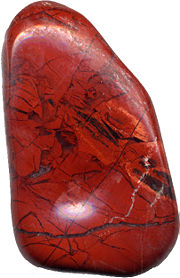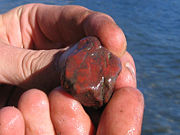Difference between revisions of "Jasper" - New World Encyclopedia
({{Contracted}}) |
|||
| Line 1: | Line 1: | ||
| − | {{Claimed}}{{Contracted}}{{Images OK}} | + | {{Claimed}}{{Contracted}}{{Images OK}}{{Submitted}}{{Approved}} |
:''This article is about the mineral. For other uses see [[Jasper (disambiguation)]]'' | :''This article is about the mineral. For other uses see [[Jasper (disambiguation)]]'' | ||
[[Image:jasper.pebble.600pix.bkg.jpg|thumb|180px|Polished jasper pebble, about one inch (2.5 centimeters) in length.]] | [[Image:jasper.pebble.600pix.bkg.jpg|thumb|180px|Polished jasper pebble, about one inch (2.5 centimeters) in length.]] | ||
Revision as of 09:36, 25 February 2007
- This article is about the mineral. For other uses see Jasper (disambiguation)
Jasper is an opaque, impure variety of quartz, usually red, yellow or brown in color. This mineral breaks with a smooth surface, and is used for ornamentation or as a gemstone. It can be highly polished and is used for vases, seals, and at one time for snuff boxes. When the colors are in stripes or bands, it is called striped or banded jasper. Jaspilite is a banded iron formation rock that often has distinctive bands of jasper. The Egyptian pebble is a brownish-yellow jasper.
Etymology and historical/mythical usage
The name means "spotted stone", and is derived from Anglo-French jaspre, from Old French jaspe, from Latin iaspidem, the accusative of iaspis, from Greek iaspis, via a Semitic language (cf. Hebrew yashepheh, Akkadian yashupu), ultimately from Persian yashp.
According to Rebbenu Bachya, the word Yasfeh in the verse Exodus 28:20 means jasper and was the stone on the Ephod representing the tribe of Benjamin.
It is described in the Book of Revelation (21:11) as: "It shown with the glory of God, and its brilliance was like that of a very precious jewel, like a jasper, clear as crystal.
Types of jasper
Jasper can appear as an opaque rock of shades of red due to mineral impurities. Patterns can arise from the formation process and from flow patterns in the sediment or volcanic ash that was saturated with silica to form jasper, yielding bands or swirls in the rock.
Jasper may be permeated by dendritic minerals providing the appearance of vegetative growths. The jasper may have been fractured and/or distorted after formation, later rebonding into discontinuous patterns or filling with another material. Heat or environmental factors may have created surface rinds (such as varnish) or interior stresses leading to fracturing.
Picture jaspers simultaneously exhibit several of these variations (such as banding, flow patterns, dendrites or color variations) resulting in what appear to be scenes or images in a cut section (as in Biggs, Deschutes, Owyhee, Poppy and other named types). Spherical flow patterns produce a distinctive orbicular appearance (porcelain jaspers such as Blue Mountain, Bruneau and Willow Creek). Complex mixes of impurities produce wild color variations (as in McDermit jasper). Healed fractures produce brecciated jasper (such as Canyon Creek). Examples of this can be seen at Llanddwyn Island. Jasper is the gemstone of the Rooster from the Chinese Zodiac.
See also
- Chalcedony
- Mineral
- Quartz
- List of minerals
ReferencesISBN links support NWE through referral fees
- Farndon, John, 2006. The Practical Encyclopedia of Rocks & Minerals: How to Find, Identify, Collect and Maintain the World's best Specimens, with over 1000 Photographs and Artworks. Lorenz Books. ISBN 0754815412 (ISBN-13: 978-0754815419)
- Hurlbut, Cornelius S., and Klein, Cornelis, 1985. Manual of Mineralogy (20th ed.). New York, NY: John Wiley and Sons. ISBN 0-471-80580-7.
- Pellant, Chris, 2002. Smithsonian Handbooks: Rocks and Minerals. New York, NY: DK Adult. ISBN 0789491060 (ISBN-13: 978-0789491060)
- Shaffer, Paul R., Herbert S. Zim, and Raymond Perlman, 2001. Rocks, Gems and Minerals. Revised and Updated edition. St. Martin's Press, Golden Guide. ISBN 1582381321 (ISBN-13: 978-1582381329).
External links
Credits
New World Encyclopedia writers and editors rewrote and completed the Wikipedia article in accordance with New World Encyclopedia standards. This article abides by terms of the Creative Commons CC-by-sa 3.0 License (CC-by-sa), which may be used and disseminated with proper attribution. Credit is due under the terms of this license that can reference both the New World Encyclopedia contributors and the selfless volunteer contributors of the Wikimedia Foundation. To cite this article click here for a list of acceptable citing formats.The history of earlier contributions by wikipedians is accessible to researchers here:
The history of this article since it was imported to New World Encyclopedia:
Note: Some restrictions may apply to use of individual images which are separately licensed.

